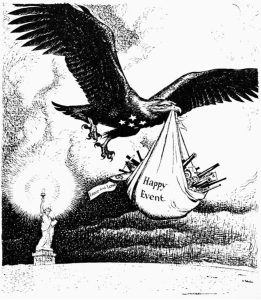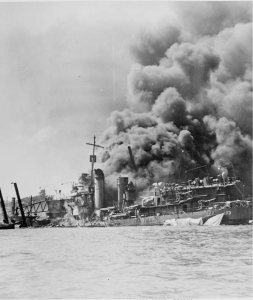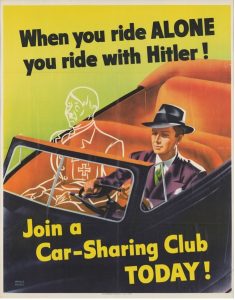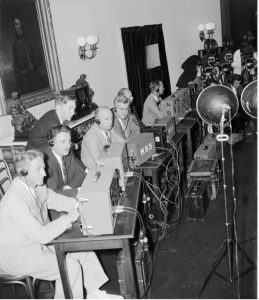37 Changing Opinion: America’s Isolationism and its Path to War by Mitchell Barry
1. Isolationism in America
Radio Press Fireside Chat 1939 by Harris & Ewing, Public Domain
| Curriculum context | Unit 1: Change and Conflict: Outcome 1: Isolationism and Capitalism in the USA (VCAA, 2020) |
| Historical context | WWII > American involvement in war |
| Historical thinking
concepts |
Explore the social, political and economic perspectives of America prior to its involvement in WWII |
| Learning intentions
|
To conceptualise the way that American politics shaped the social sentiments to engaging in another war.
Understand the barriers in place by congress to intervening in armed conflict beyond American borders. Create a point of reference for students to understand how social change can occur through political leadership. |
Activity
Overview
President Roosevelt recognised the threats that the Axis Powers posed in Europe but most American citizens were focused on the financial burdens they faced due to the ongoing effects of the Great Depression. They also still felt the losses of WWI and the terror associated with an overseas war. Many Americans felt protected by the war in Europe by the ocean that separated their continent from Asia and Europe. Roosevelt recognised this and aimed to assist allied nations that were already at war with the axis powers of Germany, Italy and Japan. In 1939, the American army was in no state to go to war with few enlistments and equipment to support this. Also, the Neutrality laws that were put in place in the 1930s limited the sale of American weaponry to nations that were at war putting President Roosevelt in a tight situation.
Individual task: Source analysis
Historical source: September 3, 1939: Fireside Chat 14: On the European War
This activity is aimed at developing your analytical skills by identifying what President Roosevelt was saying in his address to the nation and how it would be received by the American people. First, you will listen and read through the primary source of President Roosevelts Fireside Chat, September 3, 1939 and highlight all key information that relates to anti-war sentiment and protecting American interests. Remember to consider the lived experiences of Americans during WWI and the Great Depression.
Once you have read through the speech you must consider how this will affect a broad range of citizens (wealthy, poor, immigrant, person of colour, female, child, old, young, etc.) then respond in paragraph form to the questions below. Be sure to draw upon our previous lessons on WWI, the Great Depression and the associated Wall Street Crash of 1929.
- How does President Roosevelt assure and comfort Americans in the threat of war? (Provide 3 examples)
- What arguments does Roosevelt use to maintain the Isolationist stance of America? (Provide 3 examples)
- How does President Roosevelt maintain ‘national unity’ in his citizens?
- What affect does the quote ‘This nation will remain a neutral nation, but I cannot ask that every American remain neutral in thought as well’ have on American citizens? How does this separate people and politics? How does it position America moving forward?
Group task: Historical source analysis
Break into small groups and analyse the image below. Discuss how the American government were moving away from Isolationism through the Neutrality laws of the 1930s and slowly edging toward war intervention with the Lend Lease Act of 1941.
The following resources will help you contextualise Americas shift from the Neutrality Laws and toward the Lend Lease act:
- US Neutrality Acts of the 1930s and the Lend-Lease Act
- WW2: The Resource War – Lend-Lease – Extra History – #2
- FDR and Lying: Lend-Lease

The Way of a Stork – Punch by Leslie Illingworth, Public Domain
References
Extra History. (2016, April 13). WW2: The Resource War – Lend-Lease – Extra History – #2 [Video]. YouTube. https://www.youtube.com/watch?v=N5PTeDe4jTQ
Longley, R. (2022, July 6). US Neutrality Acts of the 1930s and the Lend-Lease Act. ThoughCo. https://www.thoughtco.com/us-neutrality-acts-of-the-1930s-and-the-lend-lease-act-4126414#:~:text=Key%20Takeaways%3A%20Neutrality%20Acts%20and,provisions%20of%20the%20Neutrality%20Acts.
PBS. (2011, October 10). FDR and Lying: Lend-Lease. [Video]. PBS. https://www.pbs.org/video/american-experience-fdr-and-lying-lend-lease/
Roosevelt, F. D. (1939, September 3). Fireside Chat 14: On the European War. University of Virginia. https://millercenter.org/the-presidency/presidential-speeches/september-3-1939-fireside-chat-14-european-war
VCAA. (2020). VCE Study Design: History 2022-2026. Victorian Curriculum And Assessment Authority. https://www.vcaa.vic.edu.au/curriculum/vce/vce-study-designs/history/Pages/index.aspx
2. Nationalism and the American war effort

Naval photograph documenting the Japanese attack of Pearl Harbour, Author unknown (Public Domain)
| Curriculum context | VCE Modern History Unit 1: Change and Conflict: Outcome 1: Isolationism and Capitalism in the USA (VCAA, 2020) |
| Historical context | WWII > American involvement in war |
| Historical thinking
concepts |
Explore the social, political and economic perspectives of America prior to its involvement in WWII |
| Learning intentions | Understand why America became heavily involved in the war effort after the Japanese attack on Pearl Harbour.
Understand the removal of barriers previously put in place by congress that allowed full intervention in World War II. Understand how political influence can mobilise a society to adapt to new laws and social standards through speeches and propaganda. |
Activity
Overview
Prior to Japan’s attack on Pearl Harbour, many Americans were against involvement in what was considered a European war. Though within hours of the attack, public opinion changed dramatically, and citizens were inspired to support the war effort to protect itself as the war had now come to them. President Roosevelt, an avid supporter of the Allied war effort, released another fireside chat hours after the Japanese attack on Pearl Harbour. This address to the nation outlined the political change from non-involvement to an ‘all in’ approach to the war effort. World War II was now no longer a political issue becoming a social issue as citizens now felt the immediate threat from the Axis powers. We will investigate how the Japanese bombing of Pearl Harbour was used as a tool to inspire the American population to contribute to the war effort.
Group task
Part 1: Historical source analysis
Primary Source: December 9, 1941: Fireside Chat 19: On the War with Japan
This analysis task will develop your skills in understanding how perspectives change over time in regard to politics and economics. Also, it will draw on how nations grow through changing ideologies powered by territorial aggression. In small groups, you will each select a section of the primary source transcript to read through and listen to President Roosevelt’s Fireside Chat of December 9, 1941 and highlight all key quotes that inspire nationalism and American involvement in WWII. Remember to draw from the previous lessons on American Isolationism and neutrality that focused on the anti-war sentiment within the American people. Once completed go through the sections from start to finish and share your key quotes and ideas from this national address with your group.
Key points to consider:
- What kinds of citizens are being called upon to act?
- How does Roosevelt inspire national pride?
- What new rules and laws will come into affect?
- What materials will be in high demand?
Part 2: Historical perspectives
In your groups, you will each write a 400-500 word letter to your local politician from the perspective of one American citizen in early 1942 based on the possible perspectives an historical actor from one of the following demographics and the resources below. This will help you conceptualise American war engagement and the effect it would have on the different types of American citizens. It will also strengthen your knowledge of the social impact of World War II.
- Japanese-American
- Black-American
- Working class woman
- Rural farm owner
- Jewish-American
Useful resources:
The Impact of Pearl Harbour on America
Ugly History: Japanese American incarceration camps – Densho
World War II Part 2 – The Homefront: Crash Course US History #36
Part 3: Historical source analysis
Once you have completed your letter, move onto analysing the war posters below. Consider how these posters inspire nationalism, benefit the government’s war effort and represent the different social groups of America. Some points to address include:
- Who is this poster aimed at?
- Why would the government publish this poster?
- What kinds of Americans are benefiting from this poster?

We Can Do It!, J. Howard Miller (Public Domain)

THIS IS A JAP WAR FACTORY, C. X. R. Miller (Public Domain)

When you ride alone, you ride with Hitler!, Weimer Pursell (Public Domain)
References
CrashCourse. (2013, November 2). World War II Part 2 – The Homefront: Crash Course US History #36. [Video]. YouTube. https://www.youtube.com/watch?v=HofnGQwPgqs Encyclopedia.com. (2023, June 29). Minorities on the Home Front. https://www.encyclopedia.com/history/news-and-education-magazines/minorities-home-front
Roosevelt, F. D. (1941, December 9). Fireside Chat 19: On the War with Japan. University of Virginia. https://millercenter.org/the-presidency/presidential-speeches/december-9-1941-fireside-chat-19-war-japan
TED-Ed. (2019, October 2). Ugly History: Japanese American incarceration camps – Densho. [Video]. YouTube. https://www.youtube.com/watch?v=hI4NoVWq87M Tierney, J. J. (2015, December 7). The Impact of Pearl Harbour on America. The Institute of World Politics. https://www.iwp.edu/articles/2015/12/07/the-impact-of-pearl-harbor-on-america/
VCAA. (2020). VCE Study Design: History 2022-2026. Victorian Curriculum and Assessment Authority. https://www.vcaa.vic.edu.au/curriculum/vce/vce-study-designs/history/Pages/index.aspx


